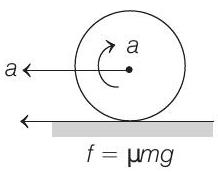Rotation 5 Question 27
39. A uniform disc of mass
(1997 C, 5M)

(a) Calculate the velocity of the centre of mass of the disc at
(b) Assuming the coefficient of friction to be
Show Answer
Answer:
Correct Answer: 39. (a)
(b)
Solution:
- (a) Between the time

So, for time

Linear retardation,
and angular acceleration,
Now, let
and
For pure rolling to take place
i.e.
Substituting in Eq. (i), we have
(b) Work done by friction
For
or
For
Therefore, total work done by friction over a time
Substituting






